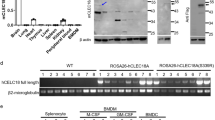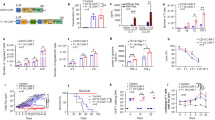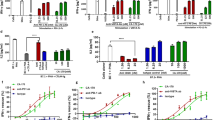Abstract
Aim:
CCL19 and its receptor CCR7 are essential molecules for facilitating the trafficking of mature dendritic cells (DCs) and helping to establish a microenvironment in lymphoid tissues to initiate primary immune responses, whereas CCL17 is required in the CCR7-CCL19-dependent migration of DCs. In this study we examined whether co-administration of CCL17 and CCL19 could enhance the immunogenicity of an anti-caries DNA vaccine, pCIA-P, in rodents.
Methods:
Plasmids encoding CCL17 (pCCL17/VAX) and CCL19 (pCCL19/VAX) were constructed. BALB/c mice were intranasally administered pCCL17/VAX, pCCL19/VAX, or pCCL17/VAX plus pCCL19/VAX, the migration of DCs to the spleen and draining lymph nodes (DLNs) was assessed with flow cytometry. The mice were co-administered pCIA-P; and the anti-PAc antibodies in the serum and saliva were detected with ELISA. Wistar rats were orally challenged with Streptococcus mutans and then administered pCIA-P in combination with pCCL17/VAX, pCCL19/VAX, or pCCL17/VAX plus pCCL19/VAX. The amount of S mutans sustained on rat molar surfaces was assessed using a colony forming assay. Caries activity was scored with the Keyes method.
Results:
Co-administration of the CCL17 and CCL19 genes in mice caused a greater increase in the number of mature DCs in the spleen and DLNs compared with administration of CCL17 or CCL19 genes alone. CCL17 and CCL19 double-adjuvant plus pCIA-P induced significantly higher levels of anti-PAc salivary IgA and anti-PAc serum IgG antibody in mice, and strengthened the ability of pCIA-P in inhibiting the colonization of S mutans on rat tooth surfaces. The caries activity of the combined adjuvant group was significantly lower than that of the pCCL17/VAX or the pCCL19/VAX group.
Conclusion:
A nasal adjuvant consisting of a combination of CCL17 and CCL19 attracts more mature DCs to secondary lymphoid tissues, inducing enhanced antibody responses against the anti-caries DNA vaccine pCIA-P and reducing S mutans infection in rodents.
Similar content being viewed by others
Log in or create a free account to read this content
Gain free access to this article, as well as selected content from this journal and more on nature.com
or
References
Fan MW, Bian Z, Peng ZX, Zhong Y, Chen Z, Peng B, et al. A DNA vaccine encoding a cell-surface protein antigen of Streptococcus mutans protects gnotobiotic rats from caries. J Dent Res 2002; 81: 784–7.
Davis BS, Chang GJ, Cropp B, Roehrig JT, Martin DA, Mitchell CJ, et al. West Nile virus recombinant DNA vaccine protects mouse and horse from virus challenge and expresses in vitro a noninfectious recombinant antigen that can be used in enzyme-linked immunosorbent assays. J Virol 2001; 75: 4040–7.
Garver KA, LaPatra SE, Kurath G . Efficacy of an infectious hematopoietic necrosis (IHN) virus DNA vaccine in Chinook Oncorhynchus tshawytscha and sockeye O. nerka salmon. Dis Aquat Organ 2005; 64: 13–22.
Bergman PJ, Camps-Palau MA, McKnight JA, Leibman NF, Craft DM, Leung C, et al. Development of a xenogeneic DNA vaccine program for canine malignant melanoma at the Animal Medical Center. Vaccine 2006; 24: 4582–5.
Draghia-Akli R, Ellis KM, Hill LA, Malone PB, Fiorotto ML . High-efficiency growth hormone-releasing hormone plasmid vector administration into skeletal muscle mediated by electroporation in pigs. FASEB J 2003; 17: 526–8.
Condon C, Watkins SC, Celluzzi CM, Thompson K, Falo LD Jr . DNA-based immunization by in vivo transfection of dendritic cells. Nat Med 1996; 2: 1122–8.
Dupuis M, Denis-Mize K, Woo C, Goldbeck C, Selby MJ, Chen M, et al. Distribution of DNA vaccines determines their immunogenicity after intramuscular injection in mice. J Immunol 2000; 165: 2850–8.
Kichaev G, Mendoza JM, Amante D, Smith TR, McCoy JR, Sardesai NY, et al. Electroporation mediated DNA vaccination directly to a mucosal surface results in improved immune responses. Hum Vaccin Immunother 2013; 9: 2041–8.
Kutzler MA, Weiner DB . DNA vaccines: ready for prime time? Nat Rev Genet 2008; 9: 776–88.
Sallusto F, Lanzavecchia A . Mobilizing dendritic cells for tolerance, priming, and chronic inflammation. J Exp Med 1999; 189: 611–4.
Ohl L, Mohaupt M, Czeloth N, Hintzen G, Kiafard Z, Zwirner J, et al. CCR7 governs skin dendritic cell migration under inflammatory and steady-state conditions. Immunity 2004; 21: 279–88.
Forster R, Davalos-Misslitz AC, Rot A . CCR7 and its ligands: balancing immunity and tolerance. Nat Rev Immunol 2008; 8: 362–71.
Liu C, Lin J, Zhao L, Yang Y, Gao F, Li B, et al. Gamma-ray irradiation impairs dendritic cell migration to CCL19 by down-regulation of CCR7 and induction of cell apoptosis. Int J Biol Sci 2011; 7: 168–79.
Förster R, Schubel A, Breitfeld D, Kremmer E, Renner-Müller I, Wolf E, et al. CCR7 coordinates the primary immune response by establishing functional microenvironments in secondary lymphoid organs. Cell 1999; 99: 23–33.
Sallusto F, Lanzavecchia A . Understanding dendritic cell and T-lymphocyte traffic through the analysis of chemokine receptor expression. Immunol Rev 2000; 177: 134–40.
Gunn MD, Kyuwa S, Tam C, Kakiuchi T, Matsuzawa A, Williams LT, et al. Mice lacking expression of secondary lymphoid organ chemokine have defects in lymphocyte homing and dendritic cell localization. J Exp Med 1999; 189: 451–60.
Eo SK, Lee S, Kumaraguru U, Rouse BT . Immunopotentiation of DNA vaccine against herpes simplex virus via co-delivery of plasmid DNA expressing CCR7 ligands. Vaccine 2001; 19: 4685–93.
Westermann J, Nguyen-Hoai T, Baldenhofer G, Höpken UE, Lipp M, Dörken B, et al. CCL19 (ELC) as an adjuvant for DNA vaccination: induction of a TH1-type T-cell response and enhancement of antitumor immunity. Cancer Gene Ther 2007; 14: 523–32.
Hartoonian C, Sepehrizadeh Z, Tabatabai Yazdi M, Jang YS, Langroudi L, Amir Kalvanagh P, et al. Enhancement of immune responses by co-delivery of CCL19/MIP-3beta chemokine plasmid with HCV core DNA/protein immunization. Hepat Mon 2014; 14: e14611.
Yan YH, Qi SC, Su LK, Xu QA, Fan MW . Co-delivery of ccl19 gene enhances anti-caries DNA vaccine pCIA-P immunogenicity in mice by increasing dendritic cell migration to secondary lymphoid tissues. Acta Pharmacol Sin 2013; 34: 432–40.
Stutte S, Quast T, Gerbitzki N, Savinko T, Novak N, Reifenberger J, et al. Requirement of CCL17 for CCR7- and CXCR4-dependent migration of cutaneous dendritic cells. Proc Natl Acad Sci U S A 2010; 107: 8736–41.
Chen L, Zhu J, Li Y, Lu J, Gao L, Xu H, et al. Enhanced nasal mucosal delivery and immunogenicity of anti-caries DNA vaccine through incorporation of anionic liposomes in chitosan/DNA complexes. PLoS One 2013; 8: e71953.
Navia JM . Animal models in dental research. Tuscaloosa: University of Alabama Press; 1977. p 280.
Keyes PH . Dental caries in the molar teeth of rats. II. A method for diagnosing and scoring several types of lesions simultaneously. J Dent Res 1958; 37: 1088–99.
Hintzen G, Ohl L, del Rio ML, Rodriguez-Barbosa JI, Pabst O, Kocks JR, et al. Induction of tolerance to innocuous inhaled antigen relies on a CCR7-dependent dendritic cell-mediated antigen transport to the bronchial lymph node. J Immunol 2006; 177: 7346–54.
Junt T, Scandella E, Förster R, Krebs P, Krautwald S, Lipp M, et al. Impact of CCR7 on priming and distribution of antiviral effector and memory CTL. J Immunol 2004; 173: 6684–93.
Bonner K, Pease JE, Corrigan CJ, Clark P, Kay AB . CCL17/thymus and activation-regulated chemokine induces calcitonin gene-related peptide in human airway epithelial cells through CCR4. J Allergy Clin Immunol 2013; 132: 942–50.
Vijayanand P, Durkin K, Hartmann G, Morjaria J, Seumois G, Staples KJ, et al. Chemokine receptor 4 plays a key role in T cell recruitment into the airways of asthmatic patients. J Immunol 2010; 184: 4568–74.
Luo K, Zhang H, Zavala F, Biragyn A, Espinosa DA, Markham RB . Fusion of antigen to a dendritic cell targeting chemokine combined with adjuvant yields a malaria DNA vaccine with enhanced protective capabilities. PLoS One 2014; 9: e90413.
Hartoonian C, Sepehrizadeh Z, Mahdavi M, Arashkia A, Jang YS, Ebtekar M, et al. Modulation of hepatitis C virus core DNA vaccine immune responses by co-immunization with CC-chemokine ligand 20 (CCL20) gene as immunoadjuvant. Mol Biol Rep 2014; 41: 5943–52.
Nguyen-Hoai T, Hohn O, Vu MD, Baldenhofer G, Sayed Ahmed MS, Dörken, B, et al. CCL19 as an adjuvant for intradermal gene gun immunization in a Her2/neu mouse tumor model: improved vaccine efficacy and a role for B cells as APC. Cancer Gene Ther 2012; 19: 880–7.
Toka FN, Gierynska M, Rouse BT . Codelivery of CCR7 ligands as molecular adjuvants enhances the protective immune response against herpes simplex virus type 1. J Virol 2003; 77: 12742–52.
Juarez V, Pasolli HA, Hellwig A, Garbi N, Arregui AC . Virus-like particles harboring CCL19, IL-2 and HPV16 E7 elicit protective T cell responses in HLA-A2 transgenic mice. Open Virol J 2012; 6: 270–6.
Acknowledgements
This study was financially supported by grants from the National Natural Science Foundation of China (No 81570968 and 81271129).
Author information
Authors and Affiliations
Corresponding author
Rights and permissions
About this article
Cite this article
Yan, Yh., Yu, F., Zeng, C. et al. CCL17 combined with CCL19 as a nasal adjuvant enhances the immunogenicity of an anti-caries DNA vaccine in rodents. Acta Pharmacol Sin 37, 1229–1236 (2016). https://doi.org/10.1038/aps.2016.73
Received:
Accepted:
Published:
Issue date:
DOI: https://doi.org/10.1038/aps.2016.73
Keywords
This article is cited by
-
Two bicistronic DNA vaccines against Vibrio anguillarum and the immune effects on flounder Paralichthys olivaceus
Journal of Oceanology and Limnology (2022)



